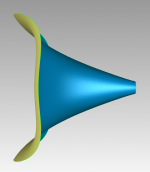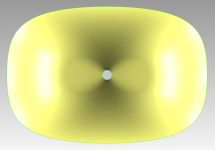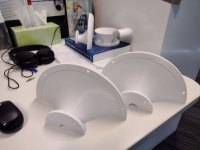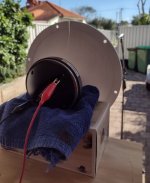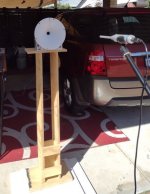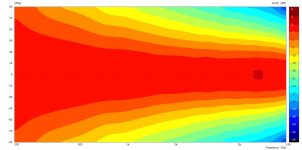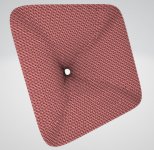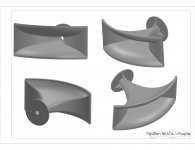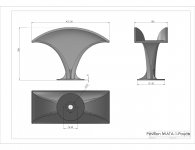Do you see where you went wrong 😉Ok Ok Ok....I was talking shop about large horns with some guys on a FB group and one guy in particular went on a rant about "it"
Why not take something like an Altec 604 and put it in large horn/waveguide. I guess it would be a VOTT inspired enclosure with a 604 in it. Probably not an original idea though.
Original 1946 Altec A6 [604 'small' cinema reflex horn] perched on a behind screen riser [basic cab = ~52.36" H x 47.92" W x 35.43" D]: http://www.voiceofthetheatre.com/images/vottcatt1945.10.jpg
It was quickly dropped for reasons long since lost, leaving the A5, which was also used as a large studio monitor in a few studios up till at least the mid '60s based on some archive photos posted on one of the Altec FB groups.
Some folks [me included] have loaded later versions in A7 cabs and in my experiment preferred it with a 500 Hz horn on top, 5 kHz HF XO.
They do cover the spectrum from 30 to at least 16k but do beam a little more than i would like over about 8k. All i have to do now is to build some new corner cabinets.
View attachment 978660
A modified JMLC-type of horn could improve DI/reduce beaming.
Attachments
Last edited:
Waveguides. Where are they?
There is a dirth of any of these kinds of designs in the real world. They predominate in software. What can pragmatically be done to physically present them to a public who wants to try them?
It seems odd to me to have so many CD choices and so few horn/waveguide choices. If these other design choices are so wonderful, they should prevail; or at least compete.
A modified JMLC-type of horn could improve DI/reduce beaming.
There is a dirth of any of these kinds of designs in the real world. They predominate in software. What can pragmatically be done to physically present them to a public who wants to try them?
It seems odd to me to have so many CD choices and so few horn/waveguide choices. If these other design choices are so wonderful, they should prevail; or at least compete.
Last edited:
G'day Paul,
If you pop over to the Ath4 thread you'll find you can create perhaps some of the best possible waveguide designs and cheaply and easily 3d print these.
Marcel's designs are available at his site here.
I have printed and measured his ST260/B (with a reasonably priced Celestion CDX1-1975) which I believe outperforms a SEOS12....
If you pop over to the Ath4 thread you'll find you can create perhaps some of the best possible waveguide designs and cheaply and easily 3d print these.
Marcel's designs are available at his site here.
I have printed and measured his ST260/B (with a reasonably priced Celestion CDX1-1975) which I believe outperforms a SEOS12....
Attachments
Last edited:
I think pro audio needs a package that is durable, protruding things are no-no. At home it is all about aesthetics, some like and some don't. So, even if it was the best thing in the world only handful would be sold. The proaudio horns dominate, biggest market I think. And the rest are a handful.
It depends on how one defines pro audio. For things that have to be shlepped around a lot like PA for example you are definitley right.
Studio monitoring is also pro audio but would allow protruding horns and waveguides. Famous example: JBL M2
But the waveguide market for studio monitoring and power HiFi is of course smaller than PA.
Regards
Charles
Studio monitoring is also pro audio but would allow protruding horns and waveguides. Famous example: JBL M2
But the waveguide market for studio monitoring and power HiFi is of course smaller than PA.
Regards
Charles
Yeah live audio 🙂 most studio and home audio waveguides are integrated to the baffle one way or another, not many available separately. Well, anyway, this is how interpret the market.
G'day Paul,
If you pop over to the Ath4 thread you'll find you can create perhaps some of the best possible waveguide designs and cheaply and easily 3d print these.
Marcel's designs are available at his site here.
I have printed and measured his ST260/B (with a reasonably priced Celestion CDX1-1975) which I believe outperforms a SEOS12....
What will be the x-over frequency and steepness for this combo? Is this intended for a 2-way design? Could you provide unnormalized fr data and distortion analysis?
There is a dirth of any of these kinds of designs in the real world. They predominate in software. What can pragmatically be done to physically present them to a public who wants to try them?
It seems odd to me to have so many CD choices and so few horn/waveguide choices. If these other design choices are so wonderful, they should prevail; or at least compete.
Whatever floats your boat...
In this thread, the importance of hornloading has never been ignored or underestimated.
For the same reason there's a lower usable limit specified for most commercially available horns.
With the exception of some custom products, like those offered by Autotech, Eckhorn and others, commercially available horns are to be mounted in a baffle.
Since these horns are also undersized (for portability), diffraction and reflection are often inevitable, resulting in a less clean (polar) response.
Once you hit a certain benchmark regarding DI, loading etc., and one knows how horns work, it's possible to tailor horn profiles to the desired specifications.
A few pages ago I posted some simulation plots of an axisymmetrical spherical wave horn. The profile was based on a few of my favorite numbers and combinations thereof (it also had an 808 in it 😉 ).
Below is an axisymmetrical and square flat front JMLC horn with identical parameters, except for a different value of the Lamé exponent.
The polar response will be about the same as the attached plot, but slightly more erratic due to the lack of rollback.
Attachments
Last edited:
Whatever floats your boat...
In this thread, the importance of hornloading has never been ignored or underestimated.
For the same reason there's a lower usable limit specified for most commercially available horns.
With the exception of some custom products, like those offered by Autotech, Eckhorn and others, commercially available horns are to be mounted in a baffle.
Since these horns are also undersized (for portability), diffraction and reflection are often inevitable, resulting in a less clean (polar) response.
Once you hit a certain benchmark regarding DI, loading etc., and one knows how horns work, it's possible to tailor horn profiles to the desired specifications.
A few pages ago I posted some simulation plots of an axisymmetrical spherical wave horn. The profile was based on a few of my favorite numbers and combinations thereof (it also had an 808 in it 😉 ).
Below is an axisymmetrical and square flat front JMLC horn with identical parameters, except for a different value of the Lamé exponent.
The polar response will be about the same as the attached plot, but slightly more erratic due to the lack of rollback.
What would float my boat is to see more real product of these new waveguides in the market. More real world published results. Real horns. Real drivers. Real published results to proof the modeling.
The importance of horn loading in this 2-way thread is an imperative to me. It can’t be done well without it.
I have a bias for horn loading. Controlled image in space, Low distortion, High dynamics; All of these over a large volume range.
I’d like to see an implementation of this:
William Neile Horns | Sphericalhorns
A Tribute to William Neile | Sphericalhorns
The older style Bi-radial horns also look good. Aesthetically – really good.
This thread is of great interest to me. I’m thankful for all the great contributors, like you. I hope I’m learning something. I’m in the process of making a 2-way setup for 7 channels. Bi-amped. With horns. Radian 951PB’s and XT1464’s. I have the front 3 channels setup now, horns running baffle-less, and all the HP parts are in house. I’m experimenting with a couple of different 15” woofers. I expect I will not reproduce the bottom ½ octave, or the top ½ octave. That’s ok. I can’t hear the top ½ octave anymore, anyway.
To my eyes, the XT1464 looks like a truncated IWATA horn; front and back of mouth; perhaps because it’s meant to be mounted in a baffle, and is undersized for portability. I get it. Perhaps it’s just my eyes. It’s also readily available at a reasonable price, even though I had to order them from Europe and have them shipped to the USA. It took a week from order to receipt. Eight horns – I bought one spare - cost less than one custom waveguide. I’ll make a guess that I will extract 80% of what I’m looking for 1/8th of the price. Notice the 808? 🙂
I am curious. Please explain the 808 reference.
I’m missing full pattern control in the lowest octave of the HP, but, pattern control stops at some frequency. The next commercial step for me is a ME464 horn. Seven of these is ONLY $3,500 – RME. Not a pretty package either. Joseph Crowe has an interesting and good looking offering in the form of his ES-600 Bi-Radial horn for about $4,200 for 7 horns. In any case, like with other custom waveguides, it’s a large investment, sight unheard.
There is legitimate difference of opinion about how low pattern control needs to be, and whether or not it needs to match, and be -6dB, at the crossover frequency – Consider the Strauss setup, and what kind of pattern control it has at the crossover frequency of 400Hz. Pattern control of HP, to an octave above the Schroeder frequency, is more than a heroic effort for most. I see the OP is trying to achieve that. His choice of the Axi CD may be the only reasonable choice. I needed 7 channels. The cost and size are prohibitive for me.
Also, so far, it doesn’t make sense to me to use a CD down to its first resonance.
However, I would like to see what is possible, which is why I keep reading. I have to leave the heavy math lifting to others, like you, because my math ends at Trig.
Last edited:
Below is an axisymmetrical and square flat front JMLC horn with identical parameters, except for a different value of the Lamé exponent.
Looks familiar
Rob 🙂
There is a dirth of any of these kinds of designs in the real world. They predominate in software. What can pragmatically be done to physically present them to a public who wants to try them?
It seems odd to me to have so many CD choices and so few horn/waveguide choices. If these other design choices are so wonderful, they should prevail; or at least compete.
CD meaning compression driver or constant directivity? You must mean compression driver.....Thats a good question, maybe its because whats been done is actually really good and everything else is bleeding edge on some level. If people are still making and satisfied with a tractrix horn vs a bleeding edge loading horn designed by say Docali....that means to me that we are at the last 10%, diminishing returns sorta speak.......A large horn/waveguide creates large amounts of directivity....this is basis for the majority of SQ increase seen here. Constant directivity horns/waveguide are at top as well with a different priority put at the top....Both both are still gaining SQ via large diameter....and arguing over details while the most has been taken care of by size vs passband.
Last edited:
I think pro audio needs a package that is durable, protruding things are no-no. At home it is all about aesthetics, some like and some don't. So, even if it was the best thing in the world only handful would be sold. The proaudio horns dominate, biggest market I think. And the rest are a handful.
Yes, in PRO it's all about usability, reliability and practicality (even a wrong grip or handle can be a total fail for an entire design), all other things come next.
As for availability in general, it's actually getting a little frustrating.
Manufacturing waveguides isn't that much more expensive compared to normal tweeter face-plates.
Well you use a tiny bit more raw material, costs 2-5 bucks at the very very most.
Yet most manufactures will ask a (relative) prime price for it, or only combine them with their higher tier products.
One can easily guess why that is.
CD meaning compression driver or constant directivity? You must mean compression driver.....Thats a good question, maybe its because whats been done is actually really good and everything else is bleeding edge on some level. If people are still making and satisfied with a tractrix horn vs a bleeding edge loading horn designed by say Docali....that means to me that we are at the last 10%, diminishing returns sorta speak.......A large horn/waveguide creates large amounts of directivity....this is basis for the majority of SQ increase seen here. Constant directivity horns/waveguide are at top as well with a different priority put at the top....Both both are still gaining SQ via large diameter....and arguing over details while the most has been taken care of by size vs passband.
Yes. I meant Compression Driver when I wrote CD. I should have been more clear.
I've started to read a number of bleeding edge authors' work. Docali is at the bleeding edge of my reading. I assume this is Docali:
Sphericalhorns | This is an exclusively private non-commercial blog about spherical horns.
I'm going to remain horn/waveguide type agnostic for as long as I can. I think I can learn more this way, and my experience with fuller range horns is limited to a DIYSG M-T dual horn, and the XT1464 horn.
Decades ago, I did hear a Westlake horn setup at a Chicago CES audio show. It left an impression I'll never forget. Wooden horns. Very natural sound.
Last edited:
Excursion is the other major factor to go along with directivity character....the bigger the horn/waveguide....the more efficient of a system it is, combined with the driver, leading to less excursion.
Cardioid is obviously going to be the next status quo, since a large midrange woofer is comparable to a large horn+CD, in midrange quality....tweeter waveguide on top of that
A large horn (an actual large horn) will still have a place...for me it creates extension to lower XO....theres probably some more pluses since there's obviously some drawbacks. I need to try and bring about a modernized 150hz sized 2380a....I wonder what that polar looks like at the top.
Ive purchased a 150hz elliptical horn to add to the collection...Docali suggested a guy for a custom horn build, I have yet to check into that guy...Ive got a guy who can do it for a fair price as well but in actually there is no completed horn... I only have a horn profile generated by Docali...akin to just a single surface...the inner horn....the desired thickness is a mystery at this point....the wooden elliptical tractrix should be a very good template and comparison to Docalis horn...It really seems like a cnc router would be the way to go...and a thing to do once laid off in November...ie I probably should build it myself, using this other horn to show me the ropes.
I need to pack up the AETD15ms and send them back to Wisconsin...if they measure wrong as they do for me, I guess he can exchange/fix/refund
Cardioid is obviously going to be the next status quo, since a large midrange woofer is comparable to a large horn+CD, in midrange quality....tweeter waveguide on top of that
A large horn (an actual large horn) will still have a place...for me it creates extension to lower XO....theres probably some more pluses since there's obviously some drawbacks. I need to try and bring about a modernized 150hz sized 2380a....I wonder what that polar looks like at the top.
Ive purchased a 150hz elliptical horn to add to the collection...Docali suggested a guy for a custom horn build, I have yet to check into that guy...Ive got a guy who can do it for a fair price as well but in actually there is no completed horn... I only have a horn profile generated by Docali...akin to just a single surface...the inner horn....the desired thickness is a mystery at this point....the wooden elliptical tractrix should be a very good template and comparison to Docalis horn...It really seems like a cnc router would be the way to go...and a thing to do once laid off in November...ie I probably should build it myself, using this other horn to show me the ropes.
I need to pack up the AETD15ms and send them back to Wisconsin...if they measure wrong as they do for me, I guess he can exchange/fix/refund
What would float my boat is to see more real product of these new waveguides in the market. More real world published results. Real horns. Real drivers. Real published results to proof the modeling.
The importance of horn loading in this 2-way thread is an imperative to me. It can’t be done well without it.
I have a bias for horn loading. Controlled image in space, Low distortion, High dynamics; All of these over a large volume range.
I’d like to see an implementation of this:
William Neile Horns | Sphericalhorns
A Tribute to William Neile | Sphericalhorns
The older style Bi-radial horns also look good. Aesthetically – really good.
...
To my eyes, the XT1464 looks like a truncated IWATA horn; front and back of mouth; perhaps because it’s meant to be mounted in a baffle, and is undersized for portability.
...
There is legitimate difference of opinion about how low pattern control needs to be, and whether or not it needs to match, and be -6dB, at the crossover frequency – Consider the Strauss setup, and what kind of pattern control it has at the crossover frequency of 400Hz. Pattern control of HP, to an octave above the Schroeder frequency, is more than a heroic effort for most. I see the OP is trying to achieve that. His choice of the Axi CD may be the only reasonable choice. I needed 7 channels. The cost and size are prohibitive for me.
My comment was not meant personally, apologies if it came across that way.
Your goals approach mine, except I only need 2 loudspeakers for stereo playback + I've decided to opt for 1" compression drivers and 15" midwoofers crossed between 800 and 900 Hz.
Through experiments with waveguides in the past it has become clear to me that hornloading is of fundamental importance, increasingly below 1000 Hz and regardless of driver size.
There are people who think otherwise, but then I think: what is the frame of reference?
My compression drivers are fine behind a short horn, crossed at 1200 Hz, but they need some hornloading below 1000 Hz in order to sound good, especially with occasional high SPL.
Holland & Newell published an article titled "Shorten the horn", but the depth of their own 'short' AX2 horn is still 23 cm.
Of the JBL Bi-Radial horn family, the 2344 sounds the least like a horn and also has the widest radiation. CAD and STL files are available.
The 2344 could essentially be enlarged to a 1.4" exit so that it can be used a little lower.
If you look at the cross section it becomes clear that the M2 horn is essentially an evolution of the 2344.
A comment by Greg Timbers at the launch of the JBL 4367:
"There are a ton of misconceptions regarding the speakers. I can comment through the DV run after which I was no longer involved. The speaker is essentially similar to a 4365 in overall sound performance. There are some voicing differences partially due to my desires and partially as a result of the hardware used. The 2216Nd has the low TCR wire and is very kicky and dynamic as a result. The 2430 needs to be used an octave below where it is happy (as in the M2) and has an increased amount of 2nd harmonic distortion between 750 Hz and 1500 Hz as a result. It is not horrible, but it is about 10 dB higher than the 476Mg in that range and up to 20 dB higher than the 476Be over the same octave. The increased second comes from the 2430 being a ring radiator with no suspension. It is just difficult for it to move below 1500 Hz. The Mg diaphragm is twice as thick as the Be diaphragm so it resists motion in that range to a degree. The Be has the most freedom to move in the octave at and above crossover so it is the best of the three in that regard. With that said, the 2430 has a very detailed and musical sound and is a fine driver. It is capable of much higher output levels than any of the 476 family and is therefore well suited to Sound Reinforcement and Studio use. There is no silver bullet. With good things come bad things and one has to look at the total set of compromises. The 2430 is also about 1/3 the cost of the 476 precious metal drivers."
The XT1464 is one of the best (sounding) commercial horns.
I've used Faital's LTH142 and quite liked it, although I prefer a slightly wider dispersion.
The LTH142 is a tractrix horn and the XT1454 either tractrix or exponential.
The original Iwata horns (attachments) are hyperbolic, but one could argue these all belong to the same family.
It is no exaggeration to state that Docali contributes to the further development of existing horn science (Spherical, JMLC) and discovers new profiles along the way, of which the Neile horn is the latest offshoot of the tribe.
Attachments
Last edited:
- Home
- Loudspeakers
- Multi-Way
- Is it possible to cover the whole spectrum, high SPL, low distortion with a 2-way?
